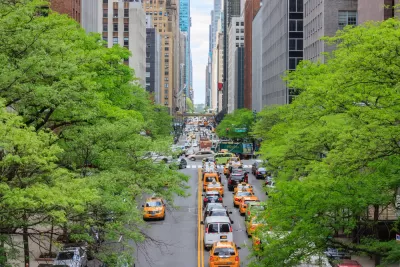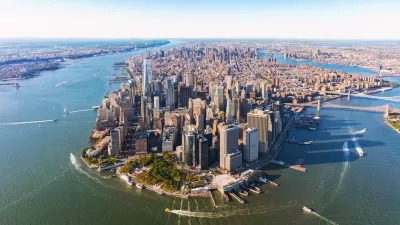The most dense neighborhood in Manhattan is surprisingly low-key.

When I read the word "hyperdensity," I imagine rows of bland, 90-story towers of the sort one might see in a science fiction movie, or perhaps in certain parts of Hong Kong. But one of America's most dense neighborhoods does not fit this stereotype.
According to the Center for Neighborhood Technology's Housing and Transportation Index, Manhattan’s most dense block group is in the Tudor City neighborhood, just south of 42nd Street and near the East River. This block has 464 dwelling units per square mile—far above the 100-200 units per acre that Jane Jacobs suggested was exemplary, or the 50 or 60 units per acre that other smart growth supporters idealize. So when I visited New York to hunt for apartments, I, of course, had to visit this block.
Tudor City shows that "hyperdense" doesn’t have to mean skyscrapers or luxurious towers. For one thing, Tudor City buildings are only 20-30 stories: not exactly walk-ups, but not extremely tall by New York standards. Buildings taller than Tudor City may actually be less dense; the most luxurious buildings might have more floors, but fewer housing units on each floor.
Another common stereotype is that density means great wealth (in luxurious high-rises) or great poverty (in public housing). But Tudor City has neither. Tudor City’s median household income is just over $90,000—above the Manhattan average, but hardly one of the richest areas in the city. (In fact, Manhattan has several block groups where the median income exceeds $250,000.)
Moreover, Tudor City's rents are actually lower than in most of midtown. I could have found a studio in Tudor City for under $2000, a extremely low figure by the standards of Manhattan doorman buildings (and, I suspect, below average even for walk-ups). Thus, Tudor City explodes the common equation of high density with high rents.
Another common stereotype is that high density means modernist sterility. But Tudor City has retail on the lower floors of some buildings, a generous selection of street trees, and a small park on Tudor City Place (the neighborhood's main street). I'm not quite sure what "human scale" means. But by the standards of midtown Manhattan, Tudor City feels more human scale than I expected. (But don't just take my word for it—look up 25 Tudor City Place on Google Street View.)

Alabama: Trump Terminates Settlements for Black Communities Harmed By Raw Sewage
Trump deemed the landmark civil rights agreement “illegal DEI and environmental justice policy.”

Planetizen Federal Action Tracker
A weekly monitor of how Trump’s orders and actions are impacting planners and planning in America.

The 120 Year Old Tiny Home Villages That Sheltered San Francisco’s Earthquake Refugees
More than a century ago, San Francisco mobilized to house thousands of residents displaced by the 1906 earthquake. Could their strategy offer a model for the present?

Opinion: California’s SB 79 Would Improve Housing Affordability and Transit Access
A proposed bill would legalize transit-oriented development statewide.

Record Temperatures Prompt Push for Environmental Justice Bills
Nevada legislators are proposing laws that would mandate heat mitigation measures to protect residents from the impacts of extreme heat.

Downtown Pittsburgh Set to Gain 1,300 New Housing Units
Pittsburgh’s office buildings, many of which date back to the early 20th century, are prime candidates for conversion to housing.
Urban Design for Planners 1: Software Tools
This six-course series explores essential urban design concepts using open source software and equips planners with the tools they need to participate fully in the urban design process.
Planning for Universal Design
Learn the tools for implementing Universal Design in planning regulations.
Clanton & Associates, Inc.
Jessamine County Fiscal Court
Institute for Housing and Urban Development Studies (IHS)
City of Grandview
Harvard GSD Executive Education
Toledo-Lucas County Plan Commissions
Salt Lake City
NYU Wagner Graduate School of Public Service






























